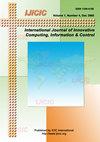马来西亚新冠肺炎病例时变系数SEIRD模型拟合
IF 1.1
Q4 COMPUTER SCIENCE, ARTIFICIAL INTELLIGENCE
International Journal of Innovative Computing Information and Control
Pub Date : 2023-05-30
DOI:10.11113/ijic.v13n1.397
引用次数: 0
摘要
本文提出了针对马来西亚COVID-19病例的分区易感-暴露-感染-恢复-死亡(SEIRD)模型。这个扩展模型比SIRD模型更适合于描述疾病传播,因为暴露(E)隔室代表处于疾病潜伏期的个体。该数学模型是一个具有时变系数的常微分方程(ode)系统,而不是传统的常系数模型。这种时间依赖性治疗是必要的,因为流行病学参数如感染率β、康复率γ和死亡率μ通常随时间而变化。然而,这一特征导致需要解决越来越多的未知数,以便将模型与实际数据拟合。Python LMfit包下的几种优化算法,如Levenberg-Marquardt、Nelder-Mead、Trust-Region Reflective和Sequential Linear Squares Programming;的方法来估计相关参数,从而使ode的数值解能以最小的误差拟合数据。Nelder-Mead以最小的误差优于其他优化算法。定性地说,结果表明,遵守检疫规则的人口比例应保持高达90%,以确保马来西亚成功达到无病或地方病平衡。本文章由计算机程序翻译,如有差异,请以英文原文为准。
Fitting Time-varying Coefficients SEIRD Model to COVID-19 Cases in Malaysia
This paper proposes a compartmental Susceptible-Exposed-Infected-Recovered-Death (SEIRD) model for COVID-19 cases in Malaysia. This extended model is more relevant to describe the disease transmission than the SIRD model since the exposed (E) compartment represents individuals in the disease's incubation period. The mathematical model is a system of ordinary differential equations (ODEs) with time-varying coefficients as opposed to the conventional model with constant coefficients. This time dependency treatment is necessary as the epidemiological parameters such as infection rate β, recovery rate γ, and death rate μ usually change over time. However, this feature leads to an increasing number of unknowns needed to be solved to fit the model with the actual data. Several optimization algorithms under Python’s LMfit package, such as Levenberg-Marquardt, Nelder-Mead, Trust-Region Reflective and Sequential Linear Squares Programming; are employed to estimate the related parameters, in such that the numerical solution of the ODEs will fit the data with the slightest error. Nelder-Mead outperforms the other optimization algorithm with the least error. Qualitatively, the result shows that the proportion of the quarantine rule-abiding population should be maintained up to 90% to ensure Malaysia successfully reaches disease-free or endemic equilibrium.
求助全文
通过发布文献求助,成功后即可免费获取论文全文。
去求助
来源期刊
CiteScore
3.20
自引率
20.00%
发文量
0
审稿时长
4.3 months
期刊介绍:
The primary aim of the International Journal of Innovative Computing, Information and Control (IJICIC) is to publish high-quality papers of new developments and trends, novel techniques and approaches, innovative methodologies and technologies on the theory and applications of intelligent systems, information and control. The IJICIC is a peer-reviewed English language journal and is published bimonthly

 求助内容:
求助内容: 应助结果提醒方式:
应助结果提醒方式:


